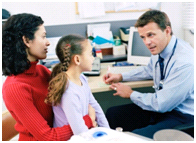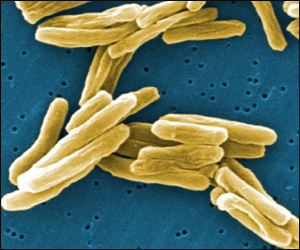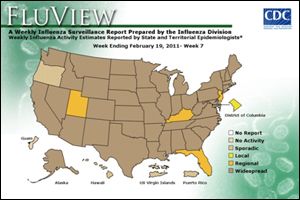Newsroom Story Ideas Archive: 2011
December 2011

World AIDS Day
Worldwide, there are 34 million people living with HIV, and according to UNAIDS, approximately 2.7 million new infections occurred in 2010. In the United States, nearly 1.2 million people are living with HIV and an estimated 50,000 new HIV infections occur each year. December 1st marks World AIDS Day, the day to raise awareness of the global impact of HIV/AIDS. This day also recognizes the success to date of global and domestic programs and the number of lives saved.
CDC is committed to saving even more lives. As a science-based public health and disease prevention agency, CDC provides support to nearly 80 countries to strengthen their national HIV programs and build sustainable public health systems through the President's Emergency Plan for AIDS Relief (PEPFAR). CDC works side-by-side with Ministries of Health in these countries and with other partners to implement sustainable HIV/AIDS interventions, and to measure their effectiveness in reducing infections and deaths from HIV/AIDS.
Within the U.S., CDC is implementing High-Impact Prevention in support of President Obama’s National HIV/AIDS Strategy, which guides the nation’s HIV prevention efforts for combating the epidemic. High-Impact Prevention is designed to maximize the impact of prevention efforts for all Americans at risk for HIV infection, including gay and bisexual men, communities of color, women, injection drug users, transgender women and men and youth. By using combinations of scientifically proven, cost-effective and scalable interventions, CDC can target the right populations in the right geographic areas -- making every prevention dollar count.
World AIDS Day is a time to remember the devastating toll this disease has taken – and continues to take – on people in the United States and around the world. It is also a day to celebrate the strides we have made in preventing HIV, and look ahead to the work we still have to do.
HIV testing should be a routine part of healthcare. CDC recommends:
- All adults and adolescents get tested at least once.
- People at high risk for HIV get tested more often. Those at the highest risk (including Injection-Drug Users and their sex partners, persons who exchange sex for money or drugs, sex partners of HIV-infected persons and heterosexuals or men who have sex with men who themselves or whose sex partners have had more than one sex partner since their most recent HIV test) get tested at least annually.
- Women get tested during each pregnancy.
Related Links:

Be Healthy: National Handwashing Awareness Week is December 4-10
Keeping hands clean through improved hand hygiene is one of the most important steps we can take to avoid getting sick and spreading germs to others. In honor of National Handwashing Awareness Week, here are some tips to stay healthy and clean by washing your hands.
How to wash hands:
- Wet your hands with clean running water and apply soap.
- Rub hands together to make a lather and scrub all surfaces.
- Continue rubbing hands for 20 seconds. Need a timer? Hum the "Happy Birthday" song from beginning to end twice.
- Rinse hands well under running water.
- Dry your hands using a clean towel or air dry them.
When to wash hands:
- Before, during, and after preparing food
- Before eating food
- Before and after caring for someone who is sick
- After using the toilet
- After changing diapers or cleaning up a child who has used the toilet
- After blowing your nose, coughing, or sneezing
- After touching an animal or animal food or waste
- After touching garbage
If soap and water are unavailable, use an alcohol-based hand sanitizer that contains at least 60% alcohol to clean hands, and wash hands with soap and water at the first opportunity. Hand sanitizers are not effective against all types of germs, and they do not work well when hands are visibly soiled.
Related Links:

Eating Healthy and Be Active During the Holidays
With balance and moderation, you can enjoy the holidays the healthy way. Choose fresh fruit as a festive and sweet substitute for candy. Select just one or two of your favorites from the host of tempting foods. Find fun ways to stay active, such as dancing to your favorite holiday music. Be active for at least 2½ hours a week. Help kids and teens be active for at least 1 hour a day. Following holiday celebrations, thoughts often turn to the New Year and getting in shape. The federal 2008 Physical Activity Guidelines for Americans can guide and motivate you to get active. Regular physical activity over months and years produces long-term health benefits and reduces the risk of many diseases. Staying in control of your weight contributes to good health now and as you age. So this holiday season, be aware of what you’re eating and stay physically active.
Related Links:

Drink More Water
Getting enough water every day is important for your health. Healthy people meet their fluid needs by drinking when thirsty and drinking with meals. Most of your fluid needs are met through the water and beverages you drink. However, you can get some fluids through the foods that you eat. For example, broth soups and foods with high water content such as celery, tomatoes, or melons can contribute to fluid intake.
Water can help your body in numerous ways. It can help keep your temperature normal, lubricate and cushion joints, protect your spinal cord and other sensitive tissues, and get rid of wastes through urination, perspiration, and bowel movements.
Your body is always in need of water when you’re in hot climates, being physically active, running a fever, or having diarrhea or vomiting. If you think you are not getting enough water, these tips may help:
- Carry a water bottle for easy access when you are at work of running errands.
- Freeze some freezer safe water bottles. Take one with you for ice-cold water all day long.
- Choose water instead of sugar-sweetened beverages. This can also help with weight management. Substituting water for one 20-ounce sugar sweetened soda will save you about 240 calories.
- Choose water when eating out. Generally, you will save money and reduce calories.
- Add a wedge of lime or lemon to your water. This can help improve the taste and help you drink more water than you usually do.
Related Links:
November 2011

Know the facts: Black women die from breast cancer more often than whites
The rate of women getting or dying from breast cancer varies by race. Breast cancer is the most commonly diagnosed cancer and second most common cause of cancer deaths among black women. At the time of diagnosis, blacks more often present with a higher stage of cancer. Although the death rate for breast cancer has declined over the past 20 years, the rate of decline has been slower for blacks. Black women are 1.4 times more likely to die from breast cancer than white women. Compared to whites, blacks have a lower rate of cancer survival for each stage of breast cancer at diagnosis. These differences have been partially explained by differences in types of tumors and access to treatment services.
All women are at risk for breast cancer, but getting regular mammograms can lower the risk of dying from breast cancer. Mammograms, an X-ray of the breast, are the best method to detect breast cancer early when it is easier to treat and before it is big enough to feel or cause symptoms. Having regular mammograms can lower the risk of dying from breast cancer. The U.S. Preventive Services Task Force has established the following guidelines for screening, but you should discuss how often you should get screened with your doctor: If you are age 50 to 74 years, be sure to have a screening mammogram every two years. If you are age 40–49 years, talk to your doctor about when and how often you should have a screening mammogram.
CDC's National Breast and Cervical Cancer Early Detection Program provides breast and cervical cancer screenings and diagnostic services to low-income, uninsured, and underinsured women across the United States. Let your readers know they can search for free and low-cost screenings in their state!
Related links:

Learn More, Breathe Better: Preventing COPD
Encourage your readers to join the Centers for Disease Control and Prevention and the National Heart, Lung, and Blood Institute this November for Chronic Obstructive Pulmonary Disease (COPD) Awareness Month. COPD refers to a group of diseases that includes emphysema, chronic bronchitis, and in some cases, asthma. It affects more than 12 million Americans and chronic lower respiratory diseases (primarily COPD) are the third leading cause of death in the United States. In the United States, tobacco use is a key factor in the development and progression of COPD, but asthma, exposure to air pollutants in the home and workplace, genetic factors, and respiratory infections also play a role.
COPD cannot be cured, but it can be prevented! Early detection is the key. A simple test can be used to measure pulmonary function and detect COPD in anyone with breathing problems. Steps to prevent COPD include avoiding tobacco use or inhaling tobacco smoke, avoiding home and workplace air pollutants, and respiratory infections to prevent early development of COPD.
Related links:
- About COPD
- Qué es esta enfermedad?
- "Learn More Breathe Better" podcast
- NHLBI "Learn More Breathe Better" Campaign

Back to the Basics: Preventing the Spread of Foodborne Disease this Holiday Season
CDC estimates that each year roughly one out of six Americans (or 48 million people) get sick, 128,000 are hospitalized, and 3,000 die from foodborne diseases. In this year alone, the CDC has engaged with state and local public health partners in the investigation of 165 outbreaks and clusters of illness. Most foodborne outbreaks are local and many result from food being contaminated when it is being prepared or served by unwashed or improperly washed hands. Scientific evidence shows that preventing illness begins with the basics.
Help keep your readers informed and safe during this holiday season by sharing the following safety tips with them.
- Clean. Wash hands, cutting boards, utensils, and countertops.
- Separate. Keep raw meat, poultry, and seafood separate from ready-to-eat foods.
- Cook. Use a food thermometer to ensure that foods are cooked to a safe internal temperature: 145°F for whole meats (allowing the meat to rest for 3 minutes before carving or consuming), 160°F for ground meats, and 165°F for all poultry.
- Chill. Keep your refrigerator below 40°F, and refrigerate food that will spoil.
- Check your steps at http://www.foodsafety.gov/keep/basics/index.html
- Report suspected illness from food to your local health department.
- Don't prepare food for others if you have diarrhea or have been vomiting.
- Be especially careful when preparing food for children, pregnant women, those in poor health, and older adults.
Related links:

You Can Control Your Asthma!
Asthma is a chronic inflammatory disorder of the airways characterized by episodic airflow obstruction, airway hyper-responsiveness, and underlying inflammation. Control of asthma requires appropriate diagnosis, effective use of medications, knowledge and understanding of the causes and consequences of the disease, and modifications of environmental exposures and behaviors that may negatively impact the disease. You can provide your readers with information on potentially effective interventions for asthma control, including methodology for identification of the interventions, results, lessons learned, information on the interventions themselves, a bibliography of reviewed literature, and case studies of several interventions.
Please share with your readers that home-based multi-trigger, multi-component interventions with an environmental focus are effective means of improving overall quality of life and productivity in children with asthma. For more information visit the Guide to Community Prevention Services website.
The benefits of controlling asthma includes fewer symptoms such as wheezing or coughing, better sleep, less missed work or school, participation in more physical activities, and fewer trips to the hospital. Be informed, take action and remember that you can control your asthma!
Related links:
- Asthma in the US
- Current Asthma Prevalence — United States, 2006–2008
- Listen/Watch: Information About Asthma
- Important Asthma Triggers

Help Your Community Become a Healthier Place to Live, Work, and Play
Did you know chronic diseases affect almost 50 percent of Americans and account for seven of the 10 leading causes of death in the United States? CDC’s Healthy Communities Program works with communities through state and national partnerships to improve community leader's skills and commitments of establishing, advancing, and maintaining effective population-based strategies that reduce the burden of chronic disease and achieve health equity.
Through this program, communities are able to implement policies that sustain environmental and systems changes that address the major risk factors—tobacco, physical inactivity, and unhealthy eating. Learn more about creating healthier communities and achieving health equity by visiting the following web sites:
Related links:
- CDC’s Healthy Communities Program
- Action Communities for Health, Innovation, and EnV ironmental ChangE (ACHIEVE)
- Pioneering Healthier Communities (PHC)
- Strategic Alliance for Health
October 2011

Share a Health-e-Card this Halloween
Interested in spreading the message to live a healthy lifestyle to your friends and family? Send them one of the many eCards the CDC has available on our website! The CDC offers more than 100 free Health-e-Cards (or “electronic greeting cards”) to send to your co-workers, friends, and family. Your readers can enjoy colorful greetings that promote safe activities, encourage healthy living, and celebrate health-related events. Halloween is approaching, but don’t get tricked by the flu! Simply click on a CDC Health-e-Card, type in an email address and name, and send safe Halloween tips to your loved ones.
Related links:

A Clear and Present Danger to Your Kids
Secondhand smoke from cigarettes is a significant threat to every child’s health. It causes numerous health problems in infants and children, including severe asthma attacks, respiratory infections, ear infections, and sudden infant death syndrome (SIDS). Their lungs grow less than children who do not breathe secondhand smoke, and they get more bronchitis and pneumonia. Wheezing and coughing are common in children who breathe secondhand smoke. Children with asthma who are around secondhand smoke have more severe and frequent asthma attacks. Children whose parents smoke around them get more ear infections. They also have fluid in their ears more often and have more operations to put in ear tubes for drainage. Remind your parent readers what steps they can take to help protect their children from secondhand smoke:
- Do not allow anyone to smoke near your child.
- Do not smoke or allow others to smoke in your home or car. Opening a window does not protect your children from smoke.
- Use a smoke-free day care center.
- Do not take your child to restaurants or other indoor public places that allow smoking.
- Teach children to stay away from secondhand smoke.
Related links:

Don’t Catch Pink Eye
Conjunctivitis is also known as pink eye. It is one of the most common and treatable eye conditions in children and adults. It is an inflammation of the thin, clear lining inside the eyelid and on the white of the eye. This inflammation gives the eye a pink or reddish color.
Conjunctivitis is caused by viruses, bacteria, allergens (like pet dander or dust mites), and irritants (like smog or swimming pool chlorine) that infect or irritate the eye and eyelid lining.
Conjunctivitis that is caused by allergens or irritants is not contagious, but a secondary infection by viruses or bacteria is possible. Viral and bacterial conjunctivitis are very contagious and spread easily and quickly from person to person. By following some simple self-care steps, like washing your hands and not touching your eyes, you can reduce the risk of getting or spreading conjunctivitis.
Related links:

STDs and the effect on pregnancy
When a woman is pregnant, STDs (or sexually transmitted diseases) can be even more serious for her and her baby. A pregnant woman with an STD can transmit that infection to her baby before, during, or after the baby’s birth. She may also experience early labor or early rupture of the membranes surrounding the baby in the uterus. Pregnant women should ask their doctors about getting screened or tested for STDs, since some doctors do not routinely perform these tests. Pregnancy does not provide women or their babies any protection against STDs. The consequences of an STD can be significantly more serious, even life threatening, for a woman and her baby if the woman becomes infected with an STD while pregnant.
It is important to remind your readers of the harmful effects of STDs and how to protect themselves and their children against infection. Some STDs, such as genital herpes and bacterial vaginosis, are quite common in pregnant women in the United States. Other STDs, notably HIV and syphilis, are much less common in pregnant women. It is also important to note that STDs can cause several serious long-term health consequences such as cervical and other cancers, chronic hepatitis, pelvic inflammatory disease, infertility, and other complications. Many women who have STDs have no signs or symptoms. The harmful outcomes of STDs in babies may include stillbirth, low birth weight, eye infection, pneumonia, infection in the baby’s blood stream, neurologic damage, blindness, deafness, acute hepatitis, meningitis, chronic liver disease, and cirrhosis. The surest way to avoid transmission of a sexually transmitted disease is to abstain from sexual contact, or to be in a long-term mutually monogamous relationship with a partner who has been tested and is known to be uninfected. Another way to protect yourself is latex condoms, when used consistently and correctly they are highly effective in preventing transmission of STDs.
Related links:
September 2011

Inside Knowledge: Get the Facts About Gynecologic Cancer Campaign
National Gynecologic Cancer Awareness Month
Ovarian cancer causes more deaths in women than any other cancer of the reproductive system. Approximately 20,000 women are diagnosed each year and, with September marking National Gynecologic Cancer Awareness Month, this is an ideal time to inform your readers about ovarian cancer. Most women who are diagnosed with ovarian cancer are not at high risk, but women who are middle-aged, have a family history of endometriosis, and have never given birth have an increased chance of getting the disease. Women of all races and ethnicities can get ovarian cancer, but, in 2007 (the most recent year for which statistics are available), white women and women of Hispanic ethnicity had the highest incidence rates.
There are currently no recommended ovarian cancer screening tests for average-risk asymptomatic women. CDC’s Inside Knowledge: Get the Facts About Gynecologic Cancer campaign encourages women to pay attention to their bodies and if they notice something that is not normal for them, and it persists for two weeks or longer, to see a doctor. Abnormal vaginal bleeding or discharge, persistent unexplained pain in the abdomen or back, bloating, and changes in bathroom habits are symptoms of ovarian cancer. However, these symptoms may be caused by many things and the only way to know what is causing them is by seeing a doctor. Help raise awareness this month by sharing the facts about ovarian cancer with your readers.
Related links:
- Inside Knowledge print materials
- Inside Knowledge TV PSAs
- Ovarian cancer screening
- Types of treatment

Ear infections – will antibiotics help?
All members of your family can be affected by ear infections and when you or your children are suffering, the answer might be antibiotics. But, when the ear infection is caused by a virus, taking antibiotics may do more harm than good. Your readers need to know that each time they take an antibiotic unnecessarily, bacteria that normally live in their bodies are encouraged to become antibiotic-resistant. This means that the next time they get sick they are more likely to become ill with an antibiotic-resistant infection.
There are three main types of ear infections, which have different causes and treatments: acute otitis media, otitis media with effusion, and otitis externa. Your healthcare provider can determine what kind of ear infection is present and if treatment is needed. Parents are warned that if your child is younger than three months old, it is important to call your doctor immediately. Signs that your child may have an ear infection are pulling at the ears, excessive crying, fluid draining from their ears and fever.
To prevent ear infections, avoid smoking or exposure to second hand smoke. Be sure to keep you and your child up to date with recommended immunizations and breastfeed your baby for 12 months or more if possible. Healthcare providers may decide to wait a couple of days before prescribing antibiotics since you or your child may get better without them. Rest, over-the-counter medicines and self-care methods may relieve the symptoms of ear infections without the misuse of antibiotics. But remember, many over-the-counter products are not recommended for young children.
Related links:
August 2011

Avoiding Tickborne Diseases
Adults, and especially children, are at risk of getting infections, such as Lyme disease or Rocky Mountain spotted fever, from tick bites year-round. However, peak tick season occurs from April through September. During these warm months, ticks, like people, are most active. Advise your readers to wear repellent, check for ticks daily and shower soon after coming indoors to wash off unseen ticks.
If your readers find an attached tick, they should use a pair of fine-tipped tweezers to grab the tick as close to the skin as possible and pull upward with a steady, even pressure. It is important to properly clean the bite area and hands following removal with rubbing alcohol, iodine scrub, or soap and water.
Anyone who develops fever or chills, a rash, or body aches and pains in the days or weeks after a tick bite, should see a health care provider. Many different species of ticks are found around the country, but only a select few bite and transmit disease to humans. To see what species of ticks put your readers at risk in your community, visit these links:
Related Links

Don′t just “shake it off”: Play It Safe When It Comes to Concussions
Concussion is a brain injury caused by a bump or blow to the head that can change the way your brain normally works. Even what seems to be a mild bump or blow to the head can be serious.
Coaches need to make sure athletes know safety comes first. Protective equipment such as mouth guards, helmets, and padding must be used correctly and consistently to help protect athletes from concussions. Encourage your team to follow the rules and practice good sportsmanship at all times. Coaches should work with school officials to ensure the appropriate individuals are available for injury assessments during all activities before the season begins. Coaches and parents need to prepare during the pre-season what to do if an athlete experiences a concussion.
To help ensure the health and safety of young athletes, CDC developed the Heads Up: Concussion in Youth Sports initiative to offer information about concussions—a type of traumatic brain injury—to coaches, parents, and athletes involved in youth sports. The "Heads Up" initiative is free and provides important information on preventing, recognizing, and responding to a concussion.
Once you complete the training and quiz, you can print out a certificate, making it easy to show your league or school you are ready for the season.
Related Links
- Concussion in Sports
- Traumatic Brain Injury (TBI) Fact Sheets
- Video: Keeping Quiet Can Keep You Out of the Game
- Radio PSA: Coach and Team [PODCAST - 0:30 seconds]
- Podcast: CDC Kidtastics: Bump on the Head [PODCAST: 2:49 minutes]
- Send a Health-e-Card: Heads Up! Tool Kit
- Download the Tool Kit on Concussion for High School Coaches

Zoonotic Hookworm in pets
Family pets bring many benefits to your reader’s households, but along with these benefits come risks to them and their pet. Cats and dogs may carry a zoonotic hookworm that can cause skin infections in humans. Zoonotic hookworms are found everywhere in the United States, but are more commonly found along the East Coast. Eggs of these worms are passed in infected animals’ stool, and under favorable conditions (warmth, moist, and shade), hatch and develop into larvae within 7 to 10 days. Humans are at risk to become infected with the hookworm larvae.
Your readers should avoid walking around barefoot in places where animal feces might have been present, especially in soil or sandy areas. Prompt disposal of pet feces is encouraged to prevent these eggs from hatching and contaminating soil. Travelers to tropical and subtropical climates are advised to wear shoes and use protective mats or other coverings to avoid direct contact with sand or soil during beach exposure. Routine veterinary care for your readers’ pets will help reduce environmental contamination with zoonotic hookworms, and will ensure both your reader’s and their pets remain healthy in your community.
Related Links
To learn more about zoonotic hookworms and how to prevent them, follow these links:

Care for the caregivers
Caregivers are people who provide assistance to someone who is, to some degree, incapacitated and needs help. Typically, recipients of care have a chronic illness or disabling condition, and need ongoing assistance with everyday tasks in order to function on a daily basis. As the number of older American rises, so does the number of needed caregivers. Caregiving exacts a tremendous toll on caregivers’ health and well-being, and accounts for significant costs to families and society as well.
Although challenging, caregiving is generally undertaken voluntarily and most people indicate that they found it personally fulfilling (Family Caregiver Alliance, 2006). Most caregivers can identify positive aspects of providing care, which can assist with coping and lower perceived burden. However, some caregivers may face stress, burden, depression, and negative health effects from their duties. Many caregivers do not adhere to recommendations to follow a healthy diet and exercise program and tend to avoid preventive care for themselves. If your readers or viewers have a family member who needs long–term care, share this RE-AIM framework, “Assuring Healthy Caregivers”, with them. You can also visit the links below to learn more about caregiving:
Related Links
July 2011

Tanned skin is damaged skin
This summer, share with readers how to protect their skin from the sun. Skin cancer is the most common form of cancer in the United States. In 2007, 58,094 people were diagnosed with melanomas of the skin, and 8,461 people died from it. The two most common types of skin cancer- basal cell and squamous cell carcinomas- are highly curable. However, melanoma, the third most common skin cancer, is more dangerous. About 65-90 percent of melanomas are caused by exposure to ultraviolet (UV) light. UV rays are an invisible kind of radiation that comes from the sun, tanning beds, and sunlamps. They can penetrate and change skin cells. A tan does not indicate good health. A tan is a response to injury, because skin cells signal that they have been hurt by the sun's UV rays by producing more pigment.
CDC recommends easy options for sun protection, including seeking shade, wearing clothing to protect exposed skin, wearing a hat with a wide brim, wearing sunglasses, and using sunscreen with SPF 15 or higher. UV rays are the greatest during the late spring and early summer in North America. Also, clouds do not block UV rays, they filter them- and sometimes only slightly. Remember to plan ahead, and keep sun protection handy- in your car, bag, or child's backpack.
Related Links


Keep Cool in HOT Weather
Getting too hot can make you sick. You can become ill from the heat if your body can't compensate for it and properly cool down. When the humidity is high, sweat won't evaporate as quickly, which keeps your body from releasing heat as fast as it may need to. People at highest risk for heat-related illness are the elderly, the very young, and people with mental illness and chronic diseases. However, even young and healthy people can get sick from the heat if they participate in strenuous physical activities during hot weather. If you see someone with warning signs of heat-related illness, including a high body temperature, throbbing headache, dizziness, nausea, weakness, fainting, confusion or unconsciousness, get them into a shady area and cool them rapidly. The CDC has available for use it's Extreme Heat Media Tool Kit that provides resources to inform audiences about ways to stay safe in extreme heat. Remind readers and viewers that there are steps to prevent heat-related illness this summer. These steps include spending time in air-conditioned buildings, staying indoors, drinking plenty of fluids, replacing salt and minerals, scheduling outdoor activities carefully, using a buddy system, and monitoring people at high risk.
Related Links
- Extreme Heat
- Frequently Asked Questions about Extreme Heat
- Heat Stress in the Elderly
- Beat the Heat (When Working Outdoors) [PODCAST - 5:30 minutes]

Take Care in the Great Outdoors
Do your readers enjoy outdoor activities like kayaking, rafting, canoeing or swimming? They may be at risk for leptospirosis, a disease caused by bacteria that is often found in bodies of fresh water. The bacteria are carried in the urine of infected animals and if the animal urinates in a lake, river, stream or soil, the disease can live there for weeks or months. During outdoor activities, people may come into close contact with fresh water by accidentally swallowing water while swimming in a lake or having an open cut that gets dirty during a muddy hike. People participating in activities involving fresh water and soil for long periods of time, especially in tropical or temperate climates, may be at higher risk for leptospirosis. Symptoms may appear anywhere from two days to four weeks after exposure. Many cases result in mild, flu-like symptoms or no symptoms at all. When symptoms do occur, they can include chills, vomiting, diarrhea, stomach pain and a rash. Serious cases can cause life-threatening infections in the kidneys, liver, brain, lungs and heart.
If your readers' outdoor activities will involve fresh water or damp soil, advise them to take steps to lower their chances of getting leptospirosis. Research the area in which you will be spending time outdoors, and be aware of potential risks. (See CDC's Travelers' Health Yellow Book.) Wear protective clothing and shoes and wait until cuts or scrapes are healed before going into fresh water or damp soil. (If you can't wait, cover cuts and scrapes with watertight bandages.) Also, try to avoid going under water or swallowing water in lakes, rivers or swamps. If you develop symptoms of the disease, be sure to see a doctor. Now head out and enjoy the great outdoors this summer!
Related Links

Hantavirus
If your readers are visiting their vacation homes or campsites for the first time this summer, remind them to take precautions when cleaning to avoid contact with areas where rodents may have been present. Hantavirus Pulmonary Syndrome (HPS) is a severe, sometimes fatal respiratory disease that is caused by an infection with hantavirus, a virus carried by rodents. You may be at risk for hantavirus by being exposed to rodents, or their droppings, urine, saliva, or nesting materials. The virus is transmitted when people breathe in contaminated air, which occurs when fresh urine or droppings are stirred up causing the virus to get into the air. Therefore, it is important to take caution when sweeping or vacuuming dust to avoid catching the disease.
Campers and hikers may also be exposed when they use infested trail shelters or camp in rodent habitats. The chance of obtaining the virus is greatest when people work, play, or live in closed spaces where rodents are actively living. Work related exposure can occur as well, when construction, utility, or pest control workers are in crawl spaces, under houses, or in vacant buildings that may have rodent population. Take precautions by eliminating or minimizing contact with rodents in your home, workplace, or campsite.
Related Links
June 2011

Caring for Children and Young Adults with Duchenne Muscular Dystrophy
Duchenne muscular dystrophy (DMD) is the most common form of muscular dystrophy among children. It most often is diagnosed when a child is 3 to 6 years of age and affects males mainly. With DMD, muscles become weaker over time; eventually people with DMD will need to use a wheelchair. There are treatments, such as the use of steroids, that can help slow down the weakening of the muscles, but currently there is no cure for DMD. Typically, people with DMD survive into early adulthood.
Explain to parents and caregivers that early diagnosis and treatment of DMD are very important. People with DMD have substantial medical needs that require specialized care. For the first time, new comprehensive, clinical DMD care considerations are available. These considerations are important for optimizing care and enhancing the quality of life for people with DMD, which can enable them to achieve their education and employment goals.
Meeting the complex needs of a person affected by DMD involves the whole family and can be challenging at times. However, finding resources, knowing what to expect, and planning for the future can help. The Guide for Families explains the new care considerations and is helpful for those with a family member with DMD.
Related Links

Preteens and Teens STILL need Vaccines
As children get older, protection from some childhood vaccines begins to wear off. Plus, older children can also develop risks for other diseases. Alert your readers that health check-ups and sports or camp physicals can be a good opportunity for preteens and teens to get the recommended vaccines. There are four vaccines recommended for preteens and teens. All kids should get a flu vaccine every year, and the Tdap vaccine, HPV vaccine and meningococcal conjugate vaccine should be given starting when kids are 11 to 12 years old. Teens may need to catch-up on vaccines they missed when they were a preteen. Teens may also need a booster of a vaccine that requires more than one dose to be fully protected. The preteen and teen vaccines not only help protect them, but also their friends, community and family members.
Related Links
- 2011 Recommended Vaccinations for Preteens and Teens
- Download your Adolescent Immunization Scheduler
- Vaccines for Children (VFC) program

Life is a Highway
If you are driving somewhere for vacation this summer, remember to practice road safety. More than 30,000 people are killed in motor vehicle crashes each year in the United States. In a one-year period, crash-related deaths in the United States resulted in an estimated $41 billion dollars in medical and work loss costs. Based on the magnitude of the health problem, motor vehicle injuries is one of CDC's "winnable battles." Furthermore, the United Nations General Assembly has proclaimed 2011 to 2020 the Decade of Action for Road Safety, a period of enhanced focus on protecting people on the world's roads.
This summer, remind your readers and viewers how important it is to stay safe on the road. According to the National Highway Traffic Safety Administration, seat belts reduce serious crash-related injuries and deaths by about 50 percent. Use a seat belt on every trip, encourage everyone in the car to buckle up, and keep children age 12 and under in the back seat. If you have a child, learn child passenger safety rules for proper seating. In addition to making sure that teens buckle up, be sure to follow your state's teen driving laws. Taking these simple precautions can help protect you and your family while you enjoy the trip.
Related Links
May 2011

Keeping Young Women Healthy and Safe by Avoiding Binge Drinking
From Spring Break trips to graduation parties to proms, Spring is full of meaningful events for high school seniors and college-aged students. At the same time, these events are notorious for dangerous drinking behaviors, particularly binge drinking, defined as 4 or more drinks for a woman and 5 or more drinks for a man per occasion. The time is ripe, therefore, to remind your readers of the health and social problems resulting from binge drinking.
Binge drinking usually leads to impairment and is associated with risky behaviors, including car crashes and violence. Binge drinking is a risk factor for sexual assault, especially among young women in college settings. There is an increase in the risk of rape or sexual assault when both the attacker and victim have used alcohol prior to the attack. Binge drinking affects decision-making around sexual activity, and women who binge drink increase their likelihood of experiencing unintended pregnancy or acquiring HIV or other sexually-transmitted infections (STIs).
Young women, in particular, are at high risk of binge drinking and experiencing related harms due to their body composition and chemistry. Women often experience the immediate effects of alcohol impairment more quickly and for a longer period of time than their male counterparts. Even when men and women drink the same amount of alcohol, women tend to have higher levels of alcohol in their blood.
Remembering these risks can help women make better choices to avoid binge drinking and stay healthy and safe during this Spring and year round.
Related Links
- Excessive Alcohol Use and Risks to Women's Health
- Vital Signs – Binge Drinking
- Underage Drinking
- Alcohol Awareness Month Feature
- Guide to Community Preventive Services

Simple Tips for Healthy Eyes
May is Healthy Vision Month and we want to encourage your readers to make vision a health priority! Approximately 14 million people aged 12 years and older do not see clearly. More than 80 percent of people with vision problems could improve their sight with eyeglasses, contact lens or vision correction surgery.
Older people, women, minority groups, and people with chronic diseases such as diabetes may be at higher risk for poor vision. Vision loss is associated with falls, depression, social isolation, and poorer health overall. The leading causes of blindness and vision loss in the United States are primarily age-related eye diseases such as macular degeneration, cataract, diabetic retinopathy, and glaucoma.
There are some easy ways to protect your eyesight. First, visit an eye care professional for a comprehensive dilated eye exam to look for common vision problems and eye diseases that often have no warning symptoms. Other tips include wearing protective eyewear and sunglasses, quitting smoking, and maintaining a healthy weight. If you spend a lot of time on the computer, look away every 20 minutes to give your eyes some rest. And always clean your hands and your contact lenses properly to avoid the risk of infection. Following these guidelines will help you keep your eyes healthy throughout your life.
Related Links

One-stop shop for health images
If you are a reporter, chances are you are constantly searching for images and photos that can add life to your story. Health reporters often rely on images to capture the attention of their viewers and convey important health messages. At CDC, we've created a site that houses a variety of health-related images. Whether you need a picture of a mosquito, an influenza virus, or a child getting vaccinated, you can find them at CDC's Public Health Image Library. You can type in keywords for a quick search or browse through the featured PHIL collections such as Influenza, Natural Disasters, Environmental Health, Bioterrorism, and EM Imagery. PHIL isn't just for reporters. Health care providers, teachers, students, public relations professionals, and other consumers may find images on this site helpful for their various needs.
Most of the images in the collection are in the public domain. If you look directly beneath the image you will see a fair use statement that tells you if the image is public domain or copyright protected. Permission is not required for public domain images, but we ask that you credit the institution and contributor when known. If the image is copyright protected, you will have to contact the content provider to obtain usage permission. Take a look around!
April 2011

Peep, chirp, quack!
Easter brings to mind brightly colored eggs, baskets full of candy, and large chocolate bunnies. However, some Easter traditions may put children at risk for illness. Live baby poultry, such as chicks, ducklings, goslings, and baby turkeys, often carry a harmful germ called Salmonella. Salmonella can cause diarrhea, vomiting, fever, and/or abdominal cramps. In severe cases, Salmonella infections can lead to hospitalization. Each spring, some children become infected with Salmonella after receiving a chick or other baby bird for Easter. However, illness can occur from baby or adult birds at any time of the year. Let your readers know that CDC recommends against buying children baby birds for Easter because of the risk of illness. And remind your readers that if they do have contact with a chick, duck, or other baby bird, or anything in the area where they live and roam, they should wash their hands to reduce the risk of getting sick.
Related Links
- CDC Salmonella web site
- CDC's Healthy Pets Healthy People
- MMWR: Multistate Outbreaks of Salmonella Infections Associated with Live Poultry — United States, 2007

Teen Dating: Stop the Violence
Did you know that in the past 12 months, one in 10 teens report being hit or physically hurt on purpose by a boyfriend or girlfriend at least once? And nearly half of all teens in relationships say they know friends who have been verbally abused. Dating violence can have a negative effect on health throughout life. Victims of teen dating violence are more likely to do poorly in school, and report binge drinking, suicide attempts, physical fighting and current sexual activity. Many teens are both victims and perpetrators of dating violence, which suggests fundamental problems in how these teens behave in relationships. A particular concern with dating violence is that victims and perpetrators may also carry the patterns of violence into future relationships. CDC's Division of Violence Prevention is undertaking a new initiative, Dating Matters: Strategies to Promote Healthy Teen Relationships, to promote respectful, nonviolent dating relationships among youth in high-risk, urban communities. Share with your parent readers how to talk to teens about the importance of developing healthy, respectful relationships.
Related Links
- What is Teen Dating Violence?
- Understanding Teen Dating Violence Fact Sheet
- Dating Matters: Understanding Teen Dating Violence Prevention
- Choose Respect

Trends in Tuberculosis
Tuberculosis (TB) is a disease caused by bacteria that usually attacks the lungs, but can attack any part of the body. If not treated properly, TB disease can be fatal. Preliminary data from CDC's National TB Surveillance System show that although TB reached an all-time low in the U.S. in 2010, TB continues to significantly affect many communities, including racial/ethnic minorities, foreign-born individuals, and persons living with HIV. In 2010, a total of 11,181 TB cases were reported in the U.S. The rate declined 3.9 percent from 2009 to 2010, to 3.6 cases per 100,000 people. Despite declines, TB rates for all racial/ethnic minorities were higher than those of whites, with TB rates seven times higher for Hispanics, eight times higher for blacks, and 25 times higher for Asians. More TB cases were reported among Hispanics than any other racial/ethnic group. The TB rate for foreign-born individuals was 11 times higher than that of those born in the U.S. TB poses a particular risk to people living with HIV, and according to available data, nearly nine percent of people with TB were also infected with HIV. Drug resistance, which makes cases of TB more difficult and costly to treat, continues to pose a threat to TB control in the U.S. In 2009, approximately 1.3 percent of TB cases were multi-drug resistant (113 total cases).
Related Links
March 2011

Not Quite in the Clear
Flu is still circulating throughout the country. During the week ending February 19, 2011, influenza activity in the U.S. remained elevated. Although the timing of peak activity is not predictable, peak activity in the United States most commonly occurs in February; however, substantial activity can occur as late as May. The proportion of deaths attributed to pneumonia and influenza was above the epidemic threshold for the fourth consecutive week. Since the beginning of this season, 41 influenza-related pediatric deaths have been reported. Remind readers that it is not too late to get a flu shot. Vaccination remains the most effective method to prevent influenza and its complications. Influenza surveillance reports for the United States are posted online weekly during October-May and are available at http://www.cdc.gov/flu/weekly/fluactivity.htm. Additional information regarding influenza viruses, influenza surveillance, influenza vaccine, influenza antiviral medications, and novel influenza A infections in humans is available at http://www.cdc.gov/flu.
Related Links

Health Beyond the Borders
As a world leader in health promotion and disease prevention, CDC works with immigrant, refugee, and migrant groups to improve their health by implementing regulations and providing guidelines for disease screening and treatment in the United States and overseas. CDC also tracks and reports disease in these populations, responds to disease outbreaks, advises U.S. partners on health care for refugee groups, and educates immigrant and refugee groups and partners.
More than 50,000 refugees relocate to the United States annually and 12,000 children are adopted from other countries. They come from all over the world and bring with them health risks and diseases common to all refugee/international adoptee populations as well as some are unique to specific populations. To prevent the spread of disease and treat migrating populations as early as possible, CDC develops regulations called technical instructions, used by physicians worldwide to screen and treat refugee and immigrant groups. The Technical Instructions have been highly successful in reducing the spread of infectious disease and in curing a multitude of diseases in individuals.
To provide further medical care for refugees and international adoptees after their arrival in the United States, CDC issued a series of Refugee Health Guidelines, describing general and optional tests that do not fall into the specific disease categories of these Technical Instructions. The guidelines were finalized in February 2011, and reflect best practices for the treatment of infectious disease in refugee groups.
Related Links

Returning to Civilian Life
Around 1.3 million men and women belong to the Reserve components of the U.S. Armed Forces. In civilian life, 60.8 percent of Guardsmen and Reservists have full-time jobs, and another 21.9 percent hold part-time employment. Once deployment ends, returning to the civilian workplace may involve making up for lost time and quickly having to readjust to different schedules, surroundings, and demands. As record numbers of National Guardsmen and Reservists return to the civilian workforce from active military duty, considerations arise in regard to safety and health on the job.
The first challenge is physical safety. Returning workers may suffer temporary or permanent impairment from a combat wound. Also, post-traumatic stress, anxiety or depression may affect their ability to complete tasks, operate machinery, or deal with work pressure. Finally, deployment of an employee for several months or a year can create disruptions for the company and work organization. These are all challenges that that returning employees and employers must face. NIOSH has begun to work with partners, including the Center for the Study of Traumatic Stress at the Uniformed Services University of the Health Sciences, to address the safety and health community's role in anticipating and meeting the needs of returning Guardsmen and Reservists and their employers, determining the breadth of knowledge surrounding this population, and determining the gaps in knowledge that need to be addressed.
Related Links
February 2011

Traveling? Prepare for countries with malaria
Think you can't get malaria? Think again. Although malaria outbreaks in the U.S. have not occurred for some time, travelers can still acquire the disease when they visit other parts of the world. You are at risk anytime you travel to a tropical or subtropical area with Anopheles mosquitoes that carry malaria parasites. But malaria is preventable. Before traveling, check out the Malaria Information by Country Table to determine if malaria is present in the country you are traveling to. Consult a health care provider to determine if you need to take a prescription medicine to prevent malaria. During your travels, make sure to prevent mosquito bites through the use of repellents, protective clothing, and insecticide-treated bed nets. If you become ill with a fever or flu-like illness while traveling, and up to 1 year after returning home, you should immediately seek professional medical care. You should tell your health care provider that you have been traveling in an area where malaria transmission occurs and ask to be tested.
Related Links

Tweet, tweet
Did you know CDC is on Facebook and Twitter, providing daily updates in both English and Spanish on a variety of health and safety topics? Your readers might like to get updates from CDC on featured health and safety tips, new social media tools, emergency preparedness and response information, and other news and events on our Facebook page. We also have the CDC en Espanol Facebook Page.
You might also like to follow @CDCgov for the latest news and events going on at CDC. Other Twitter profiles your readers might enjoy are @CDCEmergency, @CDC_eHealth, @CDCFlu, and @CDCespanol. For more social media tools, visit http://www.cdc.gov/socialmedia/.

Stomach flu? Yuck!
Noroviruses are responsible for about half of all reported outbreaks of gastroenteritis, also known as the stomach flu (vomiting, diarrhea, and stomach cramping caused by inflammation of the stomach and intestines). It's important to remember that the stomach flu has no relation to the influenza virus, or seasonal flu. Norovirus outbreaks occur throughout the year, but over 80 percent of them occur during November–April. Help protect your readers by letting them know norovirus is highly contagious and can spread from person to person, through contaminated food or water, and by touching contaminated surfaces. Common settings of norovirus outbreaks include long-term care facilities, restaurants, cruise ships, schools, and childcare facilities. Oysters and other shellfish are common sources of foodborne illness. Be sure to cook them thoroughly before eating them. Give readers advice to help prevent the spread of norovirus: Wash your hands with soap and water, carefully wash fruits and vegetables, do not prepare food while sick, and clean and disinfect contaminated surfaces. While there is no specific treatment or vaccine for norovirus, infected people should drink plenty of liquids to replace fluid, nutrients, and minerals.
Related Links

Health Disparities & Inequalities
Did you see the CDC Health Disparities & Inequalities Report CDC recently released? It is the first in a series of periodic, consolidated assessments that highlight health disparities by sex, race, and ethnicity, income, education, disability status and other social characteristics in the U.S. The information provided in the report is of vital importance in achieving the goals of Healthy People 2020 and the upcoming release of the National Partnership for Action (NPA) to End Health Disparities. CDC's report also complements the annual National Healthcare Disparities Report and the periodic reports related to Healthy People 2020. The report recommends addressing health disparities with dual intervention strategies related to health and social programs, and more broadly, access to economic, educational, employment, and housing opportunities. Check out the report and the 22 related topic fact sheets.
Related Links
- Summary of Report & Fact Sheets
- CDC Health Disparities & Inequalities Report - United States, 2011
- Office of Minority Health
January 2011

January is National Birth Defects Prevention Month
One of every 33 babies is born with a birth defect. Birth defects are a leading cause of infant deaths, accounting for about one of every five infant deaths. In addition, babies born with birth defects have a greater chance of illness and long term disability than babies without birth defects. Advise your readers that there are things a woman can do before and during pregnancy to increase her chance of having a healthy baby: see a health professional regularly, take 400 mcg of folic acid every day—starting at least one month before getting pregnant, don't drink alcohol, smoke, or use illicit drugs, and get medical conditions like diabetes under control before getting pregnant.
Women who are pregnant or thinking about becoming pregnant should also talk to a doctor or pharmacist about taking any medications, including prescription and over-the-counter medications and dietary or herbal supplements. About two-thirds of pregnant women use at least one medication during pregnancy. Many women must take medications to treat health conditions such as asthma, epilepsy, high blood pressure, and depression. It is important that women discuss with their doctor which medications are needed during pregnancy, and which are likely to be the safest to take during pregnancy. Pregnant women should not stop or start taking any type of medication that they need without first talking with a doctor. For more tips on having a healthy pregnancy and healthy baby, please visit www.cdc.gov/pregnancy.
Related Links

Start Your Resolutions Early… And Keep Them All Year Long
A new year often means new habits. Eating healthier food and becoming more physically active is often on the top of many people's list, but it's easy for these new expectations to become overwhelming. Set realistic goals for yourself! A healthy diet and regular physical activity can easily be achieved by making some of these easy, conscious decisions:
- Eat Breakfast Every Day. When you don't eat breakfast, you are likely to make up for the calories you saved by eating more later on in the day. Choose a quick, healthy breakfast option such as yogurt with fruit or toast with sliced banana and a bit of peanut butter. Many people who maintain long-term weight loss eat breakfast daily.
- Drink water. Make water more appealing by keeping it cold in the fridge or adding a slice of fruit for flavor. Choosing water keeps you from drinking something else that may be loaded with calories and sugar. People who drink sugar-sweetened beverages tend to consume more calories.
- Eat smaller food portions. When eating out, save some of your meal and take it home to make another meal or split one meal between two people. At home, try putting only the amount you want to eat in a small bowl and don't go back for more. People eat more when confronted with larger portion sizes.
- Maintain your physical activity routine. Regular physical activity is an important part of maintaining weight loss. Keep up your good habits before, during, and after the New Year. If you need extra encouragement, be physically active with a friend or relative or start an activity that may have always interested you, such as gardening or bicycling.
- Prepare a healthy lunch at home and take it to work. Taking your lunch to work helps you avoid last-minute lunch choices, which often result in selecting high-fat and high calorie options. Think about healthy lunches before your next trip to the grocery store, and stock up on healthy food items so that making your lunch will be easy.

National Cervical Cancer Awareness Month
All women are at risk for cervical cancer. Each year, approximately 12,000 women in the United States get cervical cancer. However, most cervical cancer cases are easily preventable and highly curable when found and treated early.
The human papillomavirus (HPV) is the main cause of cervical cancer. HPV is a common virus that is passed from one person to another during sex. Most of the time, HPV goes away by itself within two years and does not cause health problems. It is thought that the immune system fights off HPV naturally. It is only when HPV stays in the body for many years that it can cause these cancers. At least half of sexually active people will have HPV at some point in their lives, but few women will get cervical cancer.
Preventing Cervical Cancer through Vaccination and Screening
There are two vaccines (Cervarix and Gardasil) that can protect women against the types of HPV that cause most cervical cancers. Both vaccines are recommended for 11 and 12 year-old girls, and for females 13 through 26 years old, who did not get any or all of the three recommended doses when they were younger. These vaccines can also be given to girls beginning at age 9. It is recommended that females get the same vaccine brand for all three doses, whenever possible.
Cervical cancer can also be prevented with routine cervical cancer screening and follow-up of abnormal results. The Pap test can find abnormal cells on the cervix so that they can be removed before cancer develops. Abnormal cells often become normal over time, but can sometimes turn into cancer. These cells can usually be treated depending on their severity and on the woman's age, past medical history, and other test results. An HPV DNA test, which can find HPV on a woman's cervix, may also be used with a Pap test in certain cases. Even women who were vaccinated when they were younger need regular cervical cancer screening because the vaccines do not protect against all cervical cancers.
Other steps to lower the risk for cervical cancer include not smoking, using condoms during sex, and limiting one's number of sexual partners.

Eat Less Salt? Check!
Everyone is familiar with the typical health resolutions of eating less and exercising more, but "eating less salt" should top the list. This small step is a big change your readers can make—and stick to—that can help them lead more heart-healthy lives. Nine in 10 Americans eat too much salt, and it's driving up their blood pressure, which can lead to heart attack and stroke. In fact, nearly 400,000 deaths each year are attributed to high blood pressure, and decreasing sodium intake could prevent thousands of deaths annually. By resolving to eat more fresh fruits and vegetables and compare food labels to find low-sodium options, consumers can help reverse this deadly trend.
- The 2005 Dietary Guidelines for Americans recommend limiting sodium to less than 2,300 milligrams per day (about 1 teaspoon of table salt).
- However, individuals with hypertension, blacks, and middle-aged and older adults—70 percent of the adult population—should limit intake to 1,500 mg of sodium per day.
- The majority of Americans regularly eat more than twice the recommended daily limit of sodium every day.
- 1 in 3 Americans has high blood pressure, and most don't realize it. More than half of adults with high blood pressure—35 million—do not have the condition under control.
- High blood pressure is the leading cause of heart disease and stroke, the first and fourth most common causes of death in the United States.
- When salt intake is reduced, blood pressure begins decreasing within weeks on average.
For more information, visit http://www.cdc.gov/salt/.
- Page last reviewed: November 14, 2011
- Page last updated: November 14, 2011
- Content source: Office of the Associate Director for Communication, Division of News and Electronic Media
- Notice: This graphic notice (
 ) means that you are leaving a CDC Web site.
) means that you are leaving a CDC Web site. - Notice: Linking to a non-federal site does not constitute an endorsement by HHS, CDC or any of its employees of the sponsors or the information and products presented on the site.
View Press Releases in
Contact Us:
- Centers for Disease Control and Prevention
1600 Clifton Rd
Atlanta, GA 30333 - 800-CDC-INFO
(800-232-4636)
TTY: (888) 232-6348 - cdcinfo@cdc.gov


